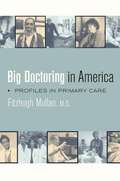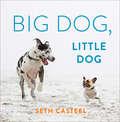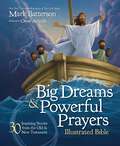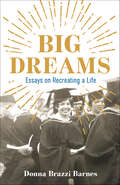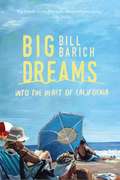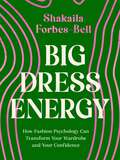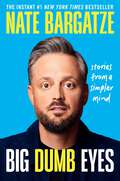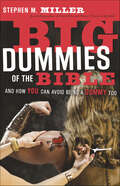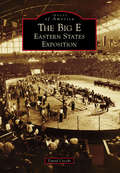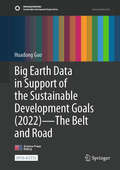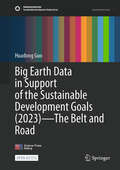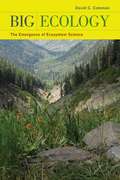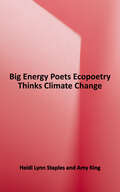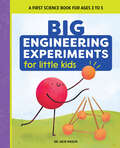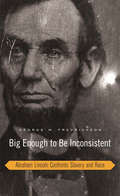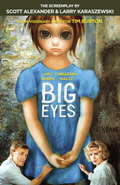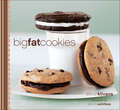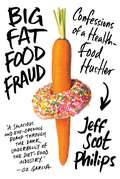- Table View
- List View
Big Doctoring in America: Profiles in Primary Care
by Fitzhugh MullanA pediatrician and writer who has moved into the health policy field makes the case for the importance of primary care by telling the stories of 15 professionals on the front lines of health care--doctors, nurse practitioners, and physicians' assistants--working in settings from urban HMOs to small-town solo practices.
Big Dog, Little Dog
by Seth CasteelFrom the bestselling photographer behind Underwater Dogs and Underwater Puppies, a new irresistibly cute concept featuring tiny dogs and giant dogs side by side.A collection of stunning photographs, each featuring two dogs: one big, one small. These unexpected pairs are utterly adorable, making this book the perfect gift for the biggest (or littlest) dog lover in your life, or the perfect coffee-table book for anyone who loves cute pups.
Big Dreams and Powerful Prayers Illustrated Bible: 30 Inspiring Stories from the Old and New Testament
by Mark BattersonMark Batterson, the New York Times bestselling author of The Circle Maker, presents thirty inspiring stories from the Old and New Testaments that will help children understand and embrace the power of prayer in their everyday lives. Alongside stunning illustrations from Omar Aranda, this powerful book will touch the hearts of young readers and help connect them to God. With prayer, all things are possible! Because prayer can change everything. In Big Dreams & Powerful Prayers Illustrated Bible, thirty powerful Bible stories are paired with real-life applications that show God can do anything if we come to him with an open heart. From Adam and Eve to David, Daniel, the disciples, Paul, and more, God has done the seemingly impossible when his people dream and pray big. And he promises to do the same for you and your child today.Big Dreams & Powerful Prayers Illustrated Bible:Pairs Mark Batterson&’s insightful lessons on prayer with Bible stories that illustrate how God provides for his people when they trust and prayIncludes Scripture taken from the NIrV translationIncludes some stories not often found in storybook BiblesContains short Prayer Points after each story that encourage children to talk to God and open their hearts to allow him to work in their lives.
Big Dreams, Daily Joys: Set goals. Get things done. Make time for what matters.
by Elise Blaha CripeFor those who feel overwhelmed by endless to do lists and the stresses that come with daily life, here is an empowering guide to establishing healthy productivity habits so that it's easy (and fun!) to accomplish long-term goals. Brimming with simple-to-follow techniques, rituals, and exercises for accomplishing day-to-day tasks and making progress on bigger goals, Big Dreams, Daily Joys offers tips on how-to organize a productive day, overcome the urge to procrastinate, make space for creativity, and achieve a healthy work-life balance. For anyone who is tackling a creative project, running their own business, or simply trying to manage time more efficiently, this is the ultimate handbook to getting things done with clarity, joy, and positivity.
Big Dreams, Small Garden: A Guide to Creating Something Extraordinary in Your Ordinary Space
by Marianne WillburnIdeal for those who dream of grand gardens but don’t know where to startA humorous and informative gardening guideWritten by columnist and blogger Marianne Willburn Have you ever longed for a garden filled with roses and orchids, but you thought that would happen somewhere else? Do you long for a spectacular garden, even though you thought you would have moved by now? Creating a stunning garden, especially when dealing with those emotions, can be tricky. Fortunately, Marianne Willburn addresses those feelings and provides a practical guide in Big Dreams, Small Garden. This guide is ideal for passionate gardeners who struggle with limited resources and want to set aside their feelings of inadequacy and jealousy. Willburn guides the reader through this experience and provides tips towards making a sanctuary in less-than-ideal situations. There are techniques with shrubbery, vegetables, general planting for beginners, and more. Willburn encourages her readers to connect with the land they call home and gives them a thorough set- by-step plan for making their dream garden without their dream circumstances.
Big Dreams: Essays on Recreating a Life
by Donna Brazzi BarnesGrowing up in the ’50s in what was then the small town of Napa, California, Donna Brazzi had loving parents, a backyard the size of a football field with a swing and a big wooden picnic table perfect for summer barbecues, a cocker spaniel named Patty, and a cat named Stinky—everything a kid could want. She was a happy child. But as she grew older and started to reach for more than a young woman from a working-class, Swiss-Italian family was expected to want—a university education and a career in the larger world beyond her hometown—she began to see that if she was going to realize her big dreams, she was going to have to fight for them. Big Dreams is Donna’s story of pursuing her education goals while confronting society’s assumptions about women’s roles in work, marriage, and motherhood from the 1950s through the mid-2000s, helped along by the evolving social movements for equality. Her journey from obedient daughter to minister’s wife to PhD in sociology was never a smooth one—but ultimately, with passion and persistence, she broke free of the family and cultural assumptions constraining her, forged her own identity, and shaped the life she wanted.
Big Dreams: Into the Heart of California
by Bill BarichThe land of opportunity, a golden Eden, the last frontier. What is this place that has given rise to countless metaphors but can still quicken the imagination? For Bill Barich, the question became a quest when he realized that home was no longer New York, where he had grown up, but California, to which he had been lured twenty years earlier. Now, in this account of his journey through California, he captures the true nature of the state behind the stereotypes. From the fogbound fishing towns of the North to the Mexican port of entry at San Ysidro, Barich describes an amazing diversity among people who have staked a claim to California’s promise. He introduces us to a Native American hairdresser and the head priest of a Sikh temple; we meet loggers, bikers, an aging lifeguard, and the prison warden whose job is to keep Charles Manson behind bars. He follows the traces of John Muir, Robert Louis Stevenson, Walt Disney, and Ronald Reagan, and weighs the impact their dreams have had on the rest of us. The result is a book that captures all the promise, heartache, grandeur, and incongruity of California and its unabashed Big Dreams.
Big Dress Energy: How Fashion Psychology Can Transform Your Wardrobe and Your Confidence
by Shakaila Forbes-BellThis is a makeover for more than just your wardrobe, it's about improving your overall well-beingYour days of screaming 'I have nothing to wear' while clawing your way out of a heaving pile of clothes are officially over. In this unique and transformational style guide, fashion psychologist Shakaila Forbes-Bell explores how our wardrobe acts as an extension of our identity and offers practical advice on how we can harness the principles of fashion psychology to upgrade our look - and dress in a way that feels completely authentic.Because what you wear matters: your clothes can affect your mood, how others perceive you and the way you see yourself. So how do you make sure that they are saying all the right things?Drawing on in-depth research and work with clients, Shakaila offers universal tips and cutting-edge advice that will empower you to shop in a more mindful, sustainable and inclusive way. From insight on how to tap into the protective power of clothes, curating a wardrobe that lasts and turning your makeup, skincare and haircare routines into legitimate forms of self-care, Big Dress Energy will invite you to see your style in a new light so that you can leave the house feeling inspired, happier and more confident. It's about damn time!
Big Dress Energy: How Fashion Psychology Can Transform Your Wardrobe and Your Confidence
by Shakaila Forbes-BellThis is a makeover for more than just your wardrobe, it's about improving your overall well-beingYour days of screaming 'I have nothing to wear' while clawing your way out of a heaving pile of clothes are officially over. In this unique and transformational style guide, fashion psychologist Shakaila Forbes-Bell explores how our wardrobe acts as an extension of our identity and offers practical advice on how we can harness the principles of fashion psychology to upgrade our look - and dress in a way that feels completely authentic. Because what you wear matters: your clothes can affect your mood, how others perceive you and the way you see yourself. So how do you make sure that they are saying all the right things?Drawing on in-depth research and work with clients, Shakaila offers universal tips and cutting-edge advice that will empower you to shop in a more mindful, sustainable and inclusive way. From insight on how to tap into the protective power of clothes, curating a wardrobe that lasts and turning your makeup, skincare and haircare routines into legitimate forms of self-care, Big Dress Energy will invite you to see your style in a new light so that you can leave the house feeling inspired, happier and more confident. It's about damn time!
Big Dumb Eyes: Stories from a Simpler Mind
by Nate BargatzeFrom one of the hottest stand-up comedians, Nate Bargatze brings his everyman comedy to the page in this hilarious collection of personal stories, opinions, and confessions. Nate Bargatze used to be a genius. That is, until the summer after seventh grade when he slipped, fell off a cliff, hit his head on a rock, and “my skull got, like, dented or something.” <p> Before this accident, he dreamed of being “an electric engineer, or a doctor that does brain stuff, or a math teacher who teaches the hardest math on earth.” Afterwards, all he could do was stand-up comedy. But the “brain stuff,” industry’s loss, is everyone else’s gain, because Nate went on to become one of today’s top-grossing comedians, breaking both attendance and streaming records. <p> In his highly anticipated first book, Nate talks about life as a non-genius. From stories about his first car (named Old Blue, a clunky Mazda with a tennis ball stick shift) and his travels as a Southerner (Northerners like to ask if he believes in dinosaurs), to tales of his first apartment where he was almost devoured by rats and his many debates with his wife over his chores, his diet, and even his definition of “shopping.” He also reflects on such heady topics as his irrational passion for Vandy football and the mysterious origins of sushi (how can a California roll come from old-time Japan?). <p> BIG DUMB EYES is full of heart. It will make readers laugh out loud and nod in recognition, but it probably won’t make them think too much. Nate’s family disputes this entire story. <b>New York Times Bestseller</b>
Big Dummies of the Bible: And How You Can Avoid Being a Dummy Too
by Stephen E. MillerHave you ever done something so dumb you wince at the thought of it? Well, you're not alone. The Bible is full of characters who made some shockingly dumb moves. Here are a few examples:A guy who sold his right to his family's estate for a bowl of soup.The couple who had the pleasure of having no rules, no boundaries--except one . . . a rule they decided to break anyway.The guy who fell in love with a woman who clearly was doing her best to have him killed.In Big Dummies of the Bible, bestselling author Stephen Miller shows readers some shockingly dumb moves by men and women of the Bible. Yet thousands of years later, we're still making the same mistakes, and the results often turn out to be as grievous now as they were for these biblical characters. Miller teaches us how to avoid these mistakes and the inevitable accompanying pain and heartache.
Big E, The: Eastern States Exposition (Images of America)
by David CecchiThe Eastern States Agricultural and Industrial Exposition was founded more than a century ago to �promote the agricultural and industrial development of the eastern states.� Held at the fairgrounds in West Springfield, Massachusetts, the inaugural event was the National Dairy Show in 1916, followed by what would become known as �The Big E,� the combined �state fair� of the six New England states: Connecticut, Massachusetts, Maine, New Hampshire, Rhode Island, and Vermont. Weathering floods, hurricanes, the Great Depression, and two world wars, it is currently one of the largest fairs in North America, with an attendance of over 1.3 million fairgoers in 2015. With photographs spanning the past century from exposition archives, area residents, and his own collection, author David Cecchi presents a fascinating visual history of what he refers to as �the fair.�
Big Earth Data in Support of the Sustainable Development Goals (Sustainable Development Goals Series)
by Huadong GuoThis open access book showcases the innovative practices of Big Earth Data methods through a collection of global comprehensive case studies to monitor and evaluate indicators for seven SDGs, i.e., zero hunger (SDG 2), clean water and sanitation (SDG 6), affordable and clean energy (SDG 7), sustainable cities and communities (SDG 11), climate action (SDG 13), life below water (SDG 14), life on land (SDG 15), and to analyzes the interactions among multiple SDGs indicators. The emphasis on Big Earth Data is highly relevant within the context of growing global challenges. Disaster risk mitigation, climate change, global food security, resource management, and environmental challenges all are interlinked through earth systems and processes that are independent of human constructs. Therefore these case studies highlight methods and practices of spatial information mining and integrated SDG evaluation, which include evaluating the synergy and trade-off relationships among the SDGs in the context of their correlations; simulating multiple indicators’ interactions in environmental, economic, and social scenarios in the context of their temporal variations; designing integrated evaluations of regional SDGs in the context of experience with the study of multiple indicators. Big Earth Data therefore has the potential to support informed policy and decision support at global, regional, and local scales.
Big Earth Data in Support of the Sustainable Development Goals (Sustainable Development Goals Series)
by Huadong GuoThis open access book showcases the innovative practices of Big Earth Data methods through a collection of comprehensive case studies from China to monitor and evaluate indicators for seven SDGs, i.e., zero hunger (SDG 2), clean water and sanitation (SDG 6), affordable and clean energy (SDG 7), sustainable cities and communities (SDG 11), climate action (SDG 13), life below water (SDG 14), life on land (SDG 15), and to analyze the interactions among multiple SDGs indicators. The emphasis on Big Earth Data is highly relevant within the context of growing global challenges. Disaster risk mitigation, climate change, global food security, resource management, and environmental challenges all are interlinked through earth systems and processes that are independent of human constructs. Therefore, these case studies highlight methods and practices of spatial information mining and integrated SDG evaluation, which include evaluating the synergy and trade-off relationships among the SDGs in the context of their correlations; simulating multiple indicators’ interactions in future environmental, economic and social scenarios in the context of their temporal variations; designing integrated evaluations of regional SDGs in the context of experience with the study of multiple indicators. Big Earth Data therefore has the potential to support informed policy and decision support at global, regional, and local scales.
Big Earth Data in Support of the Sustainable Development Goals (Sustainable Development Goals Series)
by Huadong GuoThis open-access book presents innovative applications of Big Earth Data through a set of comprehensive case studies conducted globally and in countries and regions along the Belt and Road. The studies demonstrate how advanced data methods can be employed to monitor and evaluate indicators for seven Sustainable Development Goals (SDGs): zero hunger (SDG 2), clean water and sanitation (SDG 6), affordable and clean energy (SDG 7), sustainable cities and communities (SDG 11), climate action (SDG 13), life below water (SDG 14), and life on land (SDG 15). In addition, the book explores the complex interactions among multiple SDG indicators. The emphasis on Big Earth Data is particularly timely in view of pressing global challenges. Issues such as disaster risk reduction, climate change, food security, resource management, and environmental protection are inherently interconnected through Earth systems and processes that transcend political and social boundaries. Within this context, the case studies highlight methodological advances in spatial information mining and integrated SDG evaluation, including analyzing synergies and trade-offs among SDGs through correlation studies, simulating interactions of multiple indicators under projected environmental, economic, and social scenarios, and developing integrated frameworks for regional SDG assessment. Taken together, these findings illustrate the potential of Big Earth Data to provide robust scientific evidence in support of policy formulation and decision-making at global, regional, and local levels.
Big Ecology
by David C. ColemanIn Big Ecology, David C. Coleman documents his historically fruitful ecological collaborations in the early years of studying large ecosystems in the United States. As Coleman explains, the concept of the ecosystem--a local biological community and its interactions with its environment--has given rise to many institutions and research programs, like the National Science Foundation's program for Long Term Ecological Research. Coleman's insider account of this important and fascinating trend toward big science takes us from the paradigm of collaborative interdisciplinary research, starting with the International Geophysical Year (IGY) of 1957, through the International Biological Program (IBP) of the late 1960s and early 1970s, to the Long-Term Ecological Research (LTER) programs of the 1980s.
Big Embroidery: 20 Crewel Embroidery Designs to Stitch with Wool
by Nancy NicholsonStash-busting embroidery projects for home décor, clothes, and accessories with folk art-inspired designs, by author of Modern Folk Embroidery.Big Embroidery is all about stitching beautiful designs up fast using yarn instead of embroidery thread. Designer Nancy Nicholson has created a collection of stunning designs based on traditional crewel work, and adapted them for a modern audience using everyday yarn. Crewel embroidery is traditionally done using two-ply wool and stitched onto linen. Nancy shows how to get beautiful results using different types of yarn and fabric, including upholstery fabrics, woolens, and tweeds, to create a collection of stunning quick-to-stitch projects. Choose from home decor items such as cushions, bags, wall hangings and table runners, as well as ideas for embellishing clothing. Nancy shows readers how to do all the key embroidery stitches with a stitch library featuring easy-to-follow diagrams of all the basic crewel embroidery stitches in detail.
Big Energy Poets: Ecopoetry Thinks Climate Change
by Amy King Heidi Lynn StaplesThis is more than another book on climate change, these disparate authors are collectively voices in the same struggle: How to ensure the planet's survival, where planet and body (human or otherwise) are not separate but synonymous, are inextricably tied. There is a necessary insistence in this anthology on the body politic being the earth's politic. Together, this is a creative treatise toward the integrity of continuance, and against fear of the other, the 'other' being as much 'nature' as person. The introduction asks, 'Why poetry?' to confront the urgency of climate change and all of its implications and causalities. The answer is found in the challenge taken up by these poets as they allow us access to both their poetry and their process. Here authors utilize their critical and creative practices to forward a conversation we can simply not afford to ignore. Race, gender, genocide, these poets are asking questions and further, daring to question themselves. It may surprise some how many of the poets feel the poem as inhabiting the body and it becomes easier through that understanding to see how the poet, the body of the poet, connects to the land, to the environments in which they find themselves. Indeed, several of these poets even as they put words to the page in all manner of formats and styles, literally put their bodies on the line that marks the difference between apathy and action by marching, picketing and refusing to stop creating or privileging the power of the imagination to alter our course. Read this, powerful, instructional, and inspiring, it does what we want poetry to do, move us. The writing of poetry can make one adept at discerning systems, correlations, and interconnections. Ecopoetry is the nexus of science, activism and poetics. From Anna Lena Phillips Bell's intimate litanies of trees that bring to mind the names of children in a class ledger, to Lucas de Lima's take on transmogrification, to Meta Sama's evocative conflations of 'hair,' 'river' and 'sand,' here we find the polemics of universal intersectionality, a necessary embracement, where we all have something at stake and at risk. As Brenda Hillman writes in her essay, A Brutal Encounter Recollected in Tranquility, writing may be your most necessary action but you can't be the only one."--Vievee Francis
Big Engineering Experiments for Little Kids: A First Science Book for Ages 3 to 5 (Big Experiments for Little Kids)
by Dr. Jacie MaslykExciting engineering experiments for kids ages 3 to 5 Kids are curious about how stuff works! They like to ask questions, come up with ideas, and try things out for themselves. Big Engineering Experiments for Little Kids helps activate their imaginations and shows them real engineering in action. When STEAM learning starts early, kids can prepare for scholastic success and a lifelong habit of creative and analytical thinking. Dive into engineering for kids with: 20 kid-friendly experiments—With some basic household items, kids can build a spaghetti bridge, construct a flying paper airplane, and feel how sound travels through their body! Easy instructions—These experiments are simple enough for kids to do with just a little help from a grownup, so they can practice independent learning. Engineering exploration—Each experiment shows off a different facet of engineering for kids, with explanations and thoughtful questions that illustrate how it works. Encourage little ones to explore the workings of the world with a fun book of activities that explore engineering for kids.
Big Enough to Be Inconsistent: Abraham Lincoln Confronts Slavery and Race (The W. E. B. Du Bois Lectures)
by George M. Fredrickson“Cruel, merciful; peace-loving, a fighter; despising Negroes and letting them fight and vote; protecting slavery and freeing slaves.” Abraham Lincoln was, W. E. B. Du Bois declared, “big enough to be inconsistent.” Big enough, indeed, for every generation to have its own Lincoln—unifier or emancipator, egalitarian or racist. In an effort to reconcile these views, and to offer a more complex and nuanced account of a figure so central to American history, this book focuses on the most controversial aspect of Lincoln’s thought and politics—his attitudes and actions regarding slavery and race. Drawing attention to the limitations of Lincoln’s judgment and policies without denying his magnitude, the book provides the most comprehensive and even-handed account available of Lincoln’s contradictory treatment of black Americans in matters of slavery in the South and basic civil rights in the North. George Fredrickson shows how Lincoln’s antislavery convictions, however genuine and strong, were held in check by an equally strong commitment to the rights of the states and the limitations of federal power. He explores how Lincoln’s beliefs about racial equality in civil rights, stirred and strengthened by the African American contribution to the northern war effort, were countered by his conservative constitutional philosophy, which left this matter to the states. The Lincoln who emerges from these pages is far more comprehensible and credible in his inconsistencies, and in the abiding beliefs and evolving principles from which they arose. Deeply principled but nonetheless flawed, all-too-human yet undeniably heroic, he is a Lincoln for all generations.
Big Eyes
by Tyler Stallings Larry Karaszewski Scott AlexanderWITH AN INTERVIEW WITH MARGARET KEANEThe full screenplay by award-winning Ed Wood writers Scott Alexander and Larry Karaszewski for acclaimed director Tim Burton's film Big Eyes, starring Amy Adams and Christoph Waltz.A rare close-up look into a corner of the 1950s and '60s art world and a perfectly observed account of a dysfunctional marriage, Big Eyes tells the true story of Margaret Keane, an artist who lived and worked in virtual slavery while her husband, Walter, gained fame and fortune passing himself off as the creator of his wife's wildly popular paintings. The story of their toxic relationship would culminate in a Hawaiian courtroom, as Margaret ultimately fights to save her name and reclaim her art, during a heated public court battle. This edition, illustrated with photos throughout, contains the complete screenplay, an afterword by the screenwriters, and an interview with Margaret Keane, the real-life subject of Big Eyes, by Tyler Stallings.
Big Fat Cookies
by Elinor KlivansBigger is better in the cookbook that “opens up a whole universe of giants, including chocolate chip whoppers and king-sized raisin pillows” (The Boston Globe).Nobody’s ever made baking history with a scrawny cookie. No matter what the occasion, nothing beats the big, fat, homemade kind. With this deliciously fun cookbook and a few simple ingredients, anyone can whip up a quick batch of one of fifty different gigantic crispy, chewy, or fancy-pants sandwich cookies. From classic Super Chocolate Chip to colossal Mocha Mud Mountains, Jumbo Coconut Macaroons to Lemon Whoopie Pies, this is total cookie satisfaction. Introductory material includes tips on buying the best ingredients, techniques such as mixing and forming the perfect round, baking ahead and storing, and for those who actually like to share their cookies, how to pack them up safely so they won’t break on the way to the party. So, get that sweet tooth ready and bite into a Big Fat Cookie.“Cookies don’t always get much credit for being desserts, partly because of their small size. Klivans’s creations, however, give cookies the size they need to hold their own at the end of a meal (or anytime) . . . Even those who spend very little time in the kitchen will be inspired to break out their baking sheets after thumbing through this enticing book.” —Publishers Weekly“A former pastry chef and author of several baking books, Klivans draws heavily on the classics—chocolate chip, oatmeal, shortbread, gingerbread—but she always manages to interject an unusual twist . . . a book that any cookie-loving reader will want to use over and over again.” —East Bay Times
Big Fat Food Fraud: Confessions of a Health-Food Hustler
by Jeff Scot Philips"In his rollicking, unabashed, and sometimes shocking book, Jeff Scot Philips offers an unprecedented inside look at how labels can be manipulated, regulators can be fooled, and how consumer gatekeepers--from personal trainers to nutritionists--sell high-margin 'health food' to an unsuspecting public that wants to lose weight." --Oz Garcia, bestselling author of Redesigning 50 and The Balance--Why are you are you eating diet foods and getting fatter? --Why do you still have cellulite even though you eat "healthy"? --Why don't you know what you are eating, even when you read the label? --Why does the obesity rate in America keep climbing, even though the weight-loss market is a $300 billion industry? It is because food manufacturers, the media, nutritionists, trainers, medical professionals, health inspectors, and people like Jeff Scot Philips collude for profits and are: big fat food liars.
Big Fat Gypsy Weddings: The Dresses, the Drama, the Secrets Unveiled
by Jim NallyBig Fat Gypsy Weddings has been the most talked-about show on TV and delivered ratings almost as enormous as the frothy, bejewelled frocks its subjects wear. <P><P>This book offers a window into the secret and surprising world of Gypsies and Travellers in Britain today. From spectacular first communions, strict courtings and jaw-dropping weddings, this book covers all the extraordinary rite-of-passage events in a Gypsy's life and offers an insight into their fascinating world. <P>All the favourite characters from the show are there - from Thelma the miracle dressmaker to Paddy, the champion bare-knuckle boxer. Warm, engrossing and funny, Big Fat Gypsy Weddings lays bare an exotic unseen Britain that exists right on our doorstep.
Big Fat Gypsy Weddings: The Dresses, the Drama, the Secrets Unveiled
by Jim NallyBIG FAT GYPSY WEDDINGS has been the most talked-about show on TV and delivered ratings almost as enormous as the frothy, bejewelled frocks its subjects wear. This book offers a window into the secret and surprising world of Gypsies and Travellers in Britain today. From spectacular first communions, strict courtings and jaw-dropping weddings, this book covers all the extraordinary rite-of-passage events in a Gypsy's life and offers an insight into their fascinating world. All the favourite characters from the show are there - from Thelma the miracle dressmaker to Paddy, the champion bare-knuckle boxer. Warm, engrossing and funny, BIG FAT GYPSY WEDDINGS lays bare an exotic unseen Britain that exists right on our doorstep.
